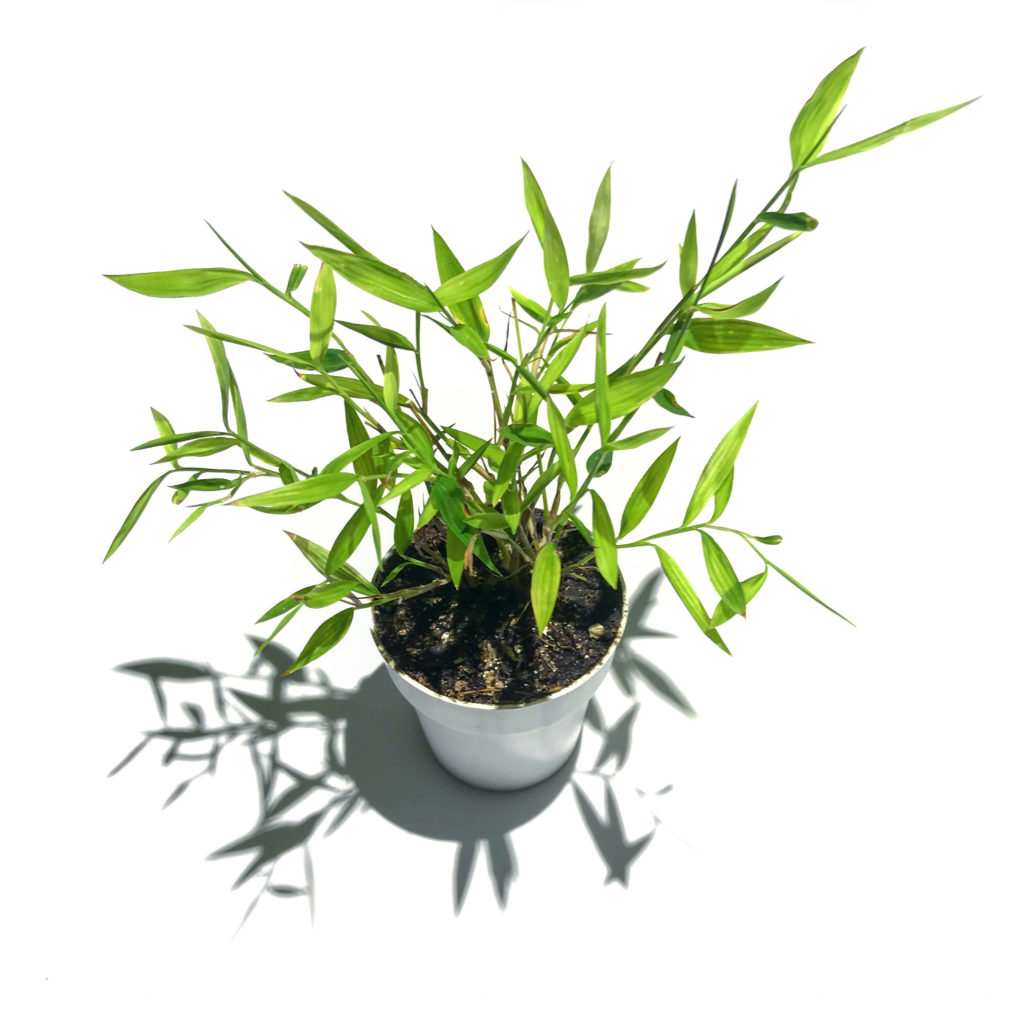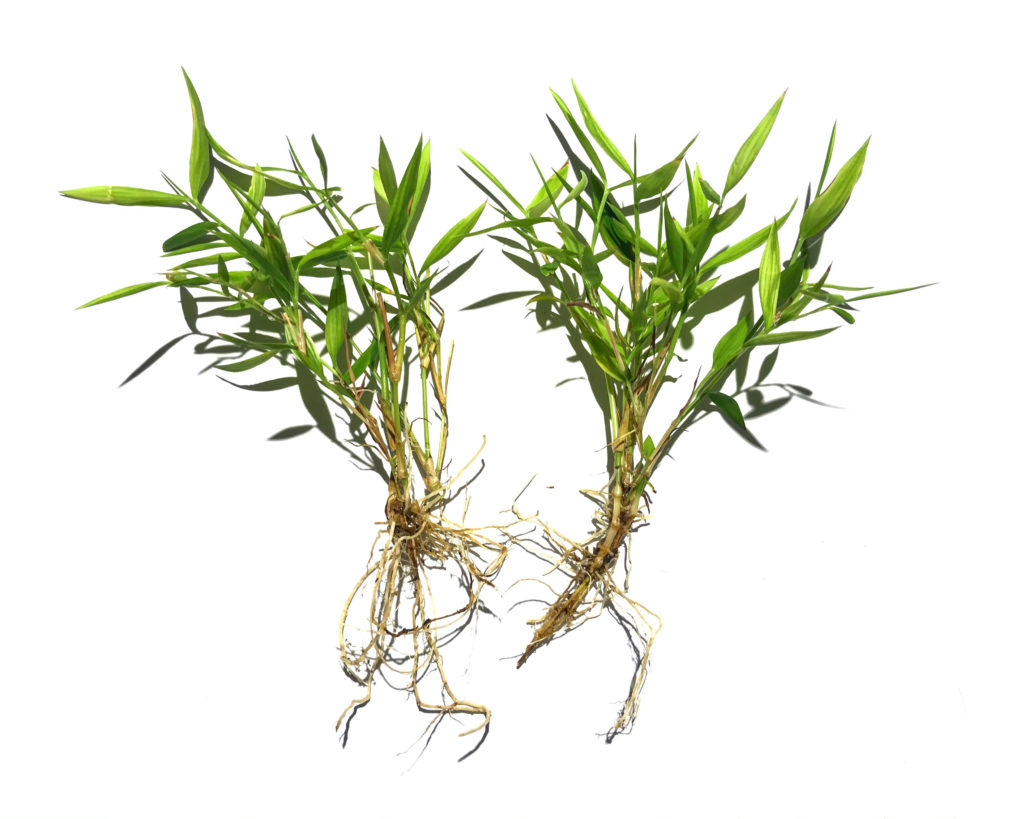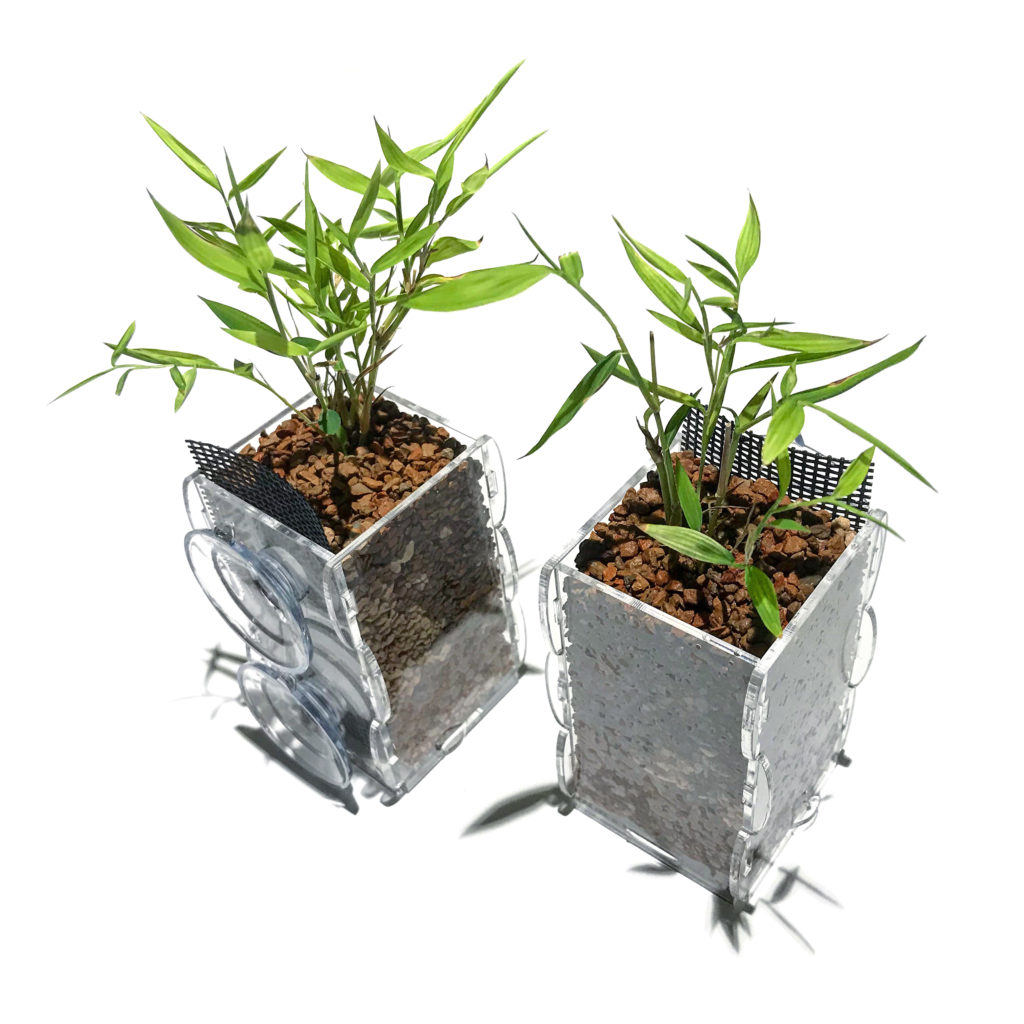
Baby Panda Bamboo (Pogonatherum sp.) growing in a 2″ (5 cm) nursery pot. This plant divided easily into two rooted starts after unpotting.
Baby Panda Bamboo (Pogonatherum sp.)
With a cuddly cute common name probably dreamed up by a marketing whiz, not a botanist, Baby Panda Bamboo (Pogonatherum sp.) is neither bamboo nor food for pandas.
The true bamboos are a monophyletic group of grasses (family Poaceae) comprising the subfamily Bambusoideae. Most bamboos are long-lived plants with woody culms (grass stems) that can reach great height, up to 115 ft (35 m) for the enormous Dragon Bamboo (Dendrocalamus giganteus) of Southeast Asia. Tribe Olyreae (a group of genera) bamboos—a few of these circulate as choice collector vivarium plants—grow as herbaceous groundcovers in Neotropical forests and woodlands. While they lack woody tissue, the Olyreae share a common ancestor with the rest of the bamboos and thus reside in the Bambusoideae.
While it is a grass and looks much like a mini bamboo, Baby Panda Bamboo (Pogonatherum sp.) is not closely related to bamboos and is classified instead in the Panicoideae subfamily of Poaceae. In horticulture, there are apparently two related species, P. crinitum and P. paniceum, with similar appearances and growth requirements. Both are offered with the ‘Baby Panda Bamboo’ trade moniker along with a few other common names. These two plants also share overlapping natural ranges extending, between them, through areas of Africa, India, Japan, China, Southeast Asia, and Australia. Both are described as growing in “sandy and rocky places.” However, given their demand for even soil moisture, they must grow in boggy depressions among boulders, along rivulets or some other microsites with ample, permanent water.
Regardless of the actual species, Baby Panda Bamboo is a cute, yet elegant plant and its sensitivity to soil moisture may explain why they are not more widely grown as a houseplant or garden plant: thorough soil drying will spell certain doom for a potted Pogonatherum. As long as the water level is maintained, there is no danger of root drying for a plant growing as riparium foliage. So a planted riparium is a good option for growing and enjoying Baby Panda Bamboo, just as it is for certain other fickle, but desirable plants, such as Peace Lilies (Spathiphyllum spp.) or Marantaceae (including Prayer Plant, Maranta leuconeura).
Baby Panda Bamboo as Nano Riparium Background Foliage
Riparium background foliage emulates the kind of tall, robust plants that grow in nearly uniform stands along the sunny margins of marshes, rivers and lakes. These may include marginal aquatic grasses (Poaceae), sedges (Cyperaceae) or cattails (Typha spp.). In swampy sites with more shade, these plants may be replaced by coarse, broad-leaved foliage, such as Spathiphyllums spp. or other aroids (Araceae).
Among the best riparium-adaptable background foliage choices are varieties of Sweet Flag (Acorus gramineus), Umbrella Sedges (Cyperus spp.) and Peace Lilies (Spathiphyllum spp.). Develop the riparium background by repeating the same kind of tall background plant in several riparium planters. Avoid mixing different kinds of background plants in the same riparium layout.
Shorter plants with more varied foliage, as well as blooms, can complement the riparium layout with just one or two examples of each as riparium accent plants. Position a single especially showy plant with brightly-patterned foliage, such as a Prayer Plants, just off-center as riparium centerpiece foliage.
While the proportions of several small riparium-adaptable accent or centerpiece plants can match nano tanks, there are fewer choices for nano riparium background foliage. With pendant lighting hung high enough above the water, a stand of Umbrella Sedges looks very good with medium-size or large aquariums, but their 18″-30″ (46 cm – 76 cm) stature is out of proportion for small enclosures. Japanese Sweetflag grows to only about 12″ (30 cm) in height, but most of its slender leaves are borne at a 45° angle, so they will reach all the way to the front glass panel in a nano tank and beyond, shading and obscuring the submerged water area below.
Baby Panda Bamboo is an excellent choice for planting the background of a nano or small riparium in a tank with 12″ (30 cm) or less of front-to-back depth. Baby Panda Bamboo culms usually grow to only about 10″ (25cm) tall as erect, fine, feathery foliage that scales very well with small aquariums, nano fish and proportional underwater scapes.

A pair of Baby Panda Bamboo (Pogonatherum sp.) divisions from single potted plant. Each of these will root in its own riparium planter.
Growing Baby Panda Bamboo in the Riparium
Baby Panda Bamboo has a fibrous root system and will establish well in a riparium planter filled with a fine-grained, baked clay substrate, such as Aqua Verdi Riparium Planter Gravel. Nutrient demand seems to be moderate, but it should receive a somewhat balanced fertilization with NPK and micronutrients, especially available Iron (Fe). Dose the water column with soluble ferts and/or use a tablet fertilizer—API Root Tabs work well—buried 1/2-way down in the riparium planter. Baby Panda Bamboo will grow lovely foliage with moderate lighting. A single bright T5 strip or equivalent LED is more than sufficient for a nano tank or small aquarium. Baby Panda Bamboo leaves and stems can become floppy or ratty with age. Prune older stems to refresh the planting and make way for new growth.
Since it will function as the taller, erect background foliage, repeat Baby Panda Bamboo in several riparium planters distributed along the length of the riparium layout, then combine with a few other selections. Dwarf Mexican Bluebell (Ruellia brittoniana ‘Katie’) pairs especially well with Baby Panda Bamboo as an accent plant. This plant usually grows to only about 6″ (15cm) in height, but reaches several inches over the water to bear its foliage horizontally. This habit creates visual depth, while also covering the riparium planters to hide from view. Dozens of familiar aquarium stem plants that can adapt as emersed foliage, such as Bacopa, Hygrophila, Ludwigia, Rotala and numerous others, also grow well in riparium planters if acquired in their emersed state or given time to transition. Most of these have fine foliage with dainty leaves that complement the texture of Baby Panda Bamboo. Additional nano riparium options include the emersed foliage aquatic ferns of the genus Marsilea, smaller Swordplants (Echinodorus spp.) in emersed form, and Rain Lilies (Zephyranthes spp.).

A pair of Baby Panda Bamboo (Pogonatherum sp.) divisions planted into Aqua Verdi Riparium Planters with a fine-grain, baked clay gravel.
Where to Shop for Baby Panda Bamboo
It can be difficult to find this plant. You might luck out by shopping the pond plant or bedding plant section of a local garden center in the springtime, but it is more likely to show up with an online search. Special plant offerings usually do not appear at the top of Google results, but you can improve your odds by combining the plant name with terms such as “nursery” or “buy live plant”. At the time of this writing, VioletBarn.com (New York) has P. crinitum listed, as well as an interesting white-variegated form. Gardino Nursery (Florida) also has it listed and in-stock for a few dollars more, but in a larger pot that might yield several divisions for several riparium planters. Both of these shops have many additional interesting selections to grow as houseplants, terrarium plants, bonsai, or for semi-aquatic situations, so be sure to click through their drop-down menus for others to combine in an order with Pogonatherum sp. ‘Baby Panda Bamboo’.





